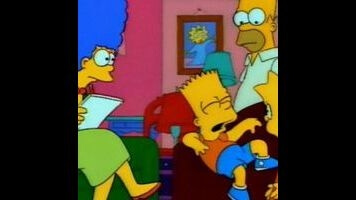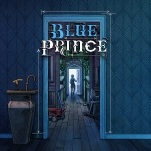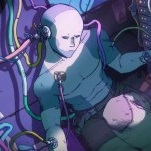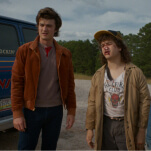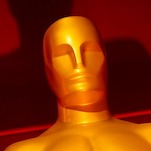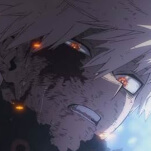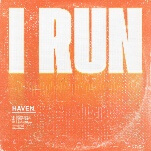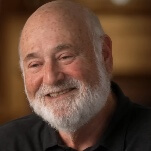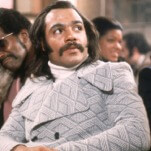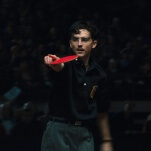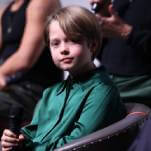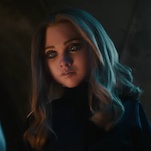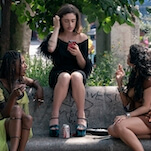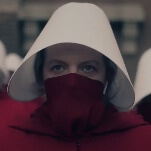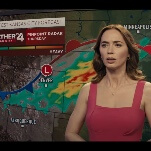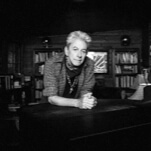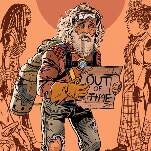“Treehouse Of Horror IV” (season five, episode five; originally aired 10/28/1993)
I was contacted by an NPR producer recently for a piece she was putting together about the ever-increasing ubiquity of pop-culture references in entertainment. As is often the case, my mind immediately went to The Simpsons and the pop-culture gauntlet of awesomeness that constitutes the beginning of its fifth season, with its takes on The Beatles, Cape Fear, rowdy campus comedies, and Citizen Kane. This sustained frenzy pop-culture-referencing and riffing climaxes with a “Treehouse Of Horror” installment constructed from bits and pieces of Night Gallery (Rod Serling’s other spooky anthology series), The Devil And Daniel Webster, the Twilight Zone episode “Terror At 20,000 Feet,” Bram Stoker’s Dracula, The Lost Boys, and finally A Charlie Brown Christmas. Mind you that’s all in one episode.
When the NPR reporter contacted me I had no idea that by the time we actually spoke The A.V Club join the pantheon of pop-culture fixtures The Simpsons deemed worthy of alluding to. We’ve finally made it to the rarified realm of Sheriff Lobo! That was, as you might imagine, an unbelievable thrill. I’ve spent the last 24 years referencing The Simpsons, so there was a pleasing symmetry and synchronicity to The Simpsons referencing, if only for the sake of a throwaway gag, my life’s work. That seems particularly appropriate because The Simpsons is the fountainhead of pop-culture references. It has perfected the pop-culture reference, but it’s also the most referenced pop-culture staple of the past 40 years.
The references of The Simpsons work even if you’re not familiar with the source material—like the linking segments in “Treehouse Of Horror IV” that find Bart channeling his inner Serling as he perambulates sinisterly around a gallery of the damned. Marge shows up to warn yet again that the program might be too intense and frightening for more delicate viewers and encourages the faint of heart to listen instead to the The War Of The World broadcast on NPR, an inspired gag that cleverly conveys how one generation’s soul-shaking terror is another generation’s quaint nostalgia piece.
This leads to the first vignette of the evening, a donut-themed parody of The Devil And Daniel Webster, Steven Vincent Benét’s classic piece of cornball Americana/valentine to the American justice system. In this version, a desperate Homer volunteers to exchange his soul to the devil in exchange for a donut (by Homer standards, if no one else's, that seems like a fair enough bargain). As if by magic the devil appears in the comfor-diddly-omforting personage of Ned Flanders (“It’s always the one you least suspect” he offers as explanation) to agree to Homer’s terms. True to form, Homer immediately agrees to the deal. In a wholly uncharacteristic bit of savvy, however, Homer figures out that as long as he doesn’t completely finish the donut of the damned, the devil cannot take his soul.
Homer’s discovery of this loophole does not please The Prince of Darkness, however. In a heartbeat, Flanders transforms from the friendliest face in Springfield to a genuinely terrifying beast (modeled after the devil in Fantasia), great and horrifying in his wrath. This turn is as instantaneous as it is dramatic. It’s a powerful illustration of a Halloween episode’s ability to morph from funny to scary and then back to funny again without missing a beat or sacrificing tone.
The writers had an awful lot of fun imagining Homer in Hell; my favorite gag finds Homer in the underworld’s ironic punishment division (The Twilight Zone would be unthinkable without such an institution) confronting what a demon foolishly imagines will be the ultimate ironic punishment: eating all the donuts in the world. Homer trumps the system, however; in his mind the concept of too much food does not exist, so he keeps happily masticating donuts at a rate that astonishes the damned and their evil overlords.
Like its source material, “The Devil And Homer Simpson” is ultimately a legal drama about the power of the American justice system to overcome the greatest evil. When Lisa points out that every American is entitled to a fair trial, the devil grudgingly acquiesces. The protagonist of The Devil And Daniel Webster has the good fortune to have the titular lawyer, the finest in the land, as his legal representative; Homer, in sharp contrast, has Lionel Hutz, the worst litigator in existence, on his side. It’s not encouraging that Hutz boasts of the extent of his legal knowledge, “Mr. Simpson, don’t worry. I watched Matlock in a bar last night. The sound wasn’t on but I think I got the gist of it.”
“The Devil And Homer Simpson” ends, like Benét’s short story, with the cursed protagonist being freed from his contract with the devil after the jury decides Homer’s soul ultimately belongs to his long-suffering wife rather than to Homer himself. It’s a plot point acknowledging that Homer belongs to Marge the same way children belong to parents upon which they are completely dependent—their bond is as much mother/child as it is husband and wife.
The second segment, “Terror At 5 1/2 Feet” is a parody/homage of a Twilight Zone premise previously utilizing the talents of William Shatner (on the original TV series) and John Lithgow (in a standout installment of The Twilight Zone: The Movie). The Simpsons version recasts Bart as a jittery passenger who sees what he imagines is a terrifying gremlin on the side of his schoolbus attempting to dismantle it piece-by-piece.
Yet whenever the increasingly freaked-out Bart tries to expose this menace to his fellow passengers, the beastie mysteriously disappears. So does the madness and horror lie in the creature on the side of the bus or the paranoia and delirium inside Bart’s mind? Like Flanders’ transformation into a conventional representation of the devil, “Terror At 5 1/2 Feet” manages the tricky feat of being genuinely terrifying yet extremely funny. The portions of the episode that deal with the gremlin are played absolutely straight, for gut-wrenching suspense, but they’re juxtaposed with all manner of hilarious business on the bus, most notably in the form of an obese transfer student from Germany and Principal Skinner (who early in the episode tells Bart, “Hello, Simpson. I’m riding the bus today because mother hid my car keys to punish me for talking to a woman on the phone. She was right to do it” with the perfect note of brainwashed detachment) coming over to tell a panic-stricken Bart, “Now I’ve gotten word that a child is using his imagination and I’ve come to put a stop to it.”
The final installment in this trilogy of terror is “Bart Simpson’s Dracula” which re-casts (or rather typecasts) Mr. Burns as a blood-sucking ghoul who invites the Simpsons to his creepy, secret-chamber-laden estate with a mind towards drinking their sweet, sweet blood. Lisa is convinced Burns is a vampire, but the rest of the family is slow on the uptake, even though Burns does everything—including writing a book entitled I Am A Vampire (with an introduction by Steve Allen)—to broadcast his true nature.
Burns ends up biting Bart and turning him into a vampire. Lisa is convinced that the only way to turn Bart back into a human being is by killing Burns, who she believes to be the head vampire. Homer finally has a moral justification for murdering Burns—“Kill my boss? Do I dare live out the American Dream?” he ponders out loud—but killing Burns does not turn Bart back into a human, because, in a closing twist, it turns out that saintly Marge is in fact the head vampire. To quote from “The Devil And Homer Simpson,” it’s always the ones you least expect.
This creepy climactic revelation that the family’s beloved, kind-hearted matriarch is a powerful ghoul is completely undercut by the Simpsons breaking the fourth wall and wishing the audience a happy ending. This leads, inexplicably but gloriously, into another genius pop-culture reference, as the Simpsons’ Halloween spectacular morphs into an homage to A Charlie Brown Christmas, with Santa’s Little Helper doing the Snoopy dance and Milhouse sitting down at a piano, Schroeder-style, in a loving homage that ends a macabre episode on a weirdly perfect note of Yuletide whimsy.
Marge recommended listening to War Of The Worlds for the squeamish because time had rendered its scare tactics adorably anachronistic. Some two decades on, however, early “Treehouse Of Horror” installments remain as funny and scary as ever.
Stray observations:
- “The only monster on this bus is a lack of proper respect for the rules.”—Skinner on the real menace facing Bart—and, to a lesser extent, society.
- “Perhaps spending the rest of your life in a madhouse will teach you some manners!”—more tough love from Skinner
- I love the Krusty series-eight trading card simply captioned, “Krusty poses for trading card photo”
- “Who’s that goat-legged fellow? I like the of his jib.”—Burns sizing up a potential new employee with a bit of a dark back story.
- Next up is “Marge On The Lam.” If memory serves, it’s a good one.
